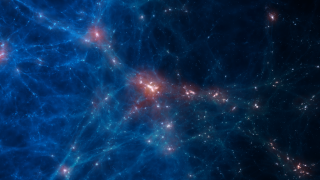Santos-Santos, Isabel M. E.; Domínguez-Tenreiro, Rosa; Granato, Gian Luigi; Brook, C. B.; Obreja, Aura
Referencia bibliográfica
Astronomy and Astrophysics, Volume 603, id.A4, 22 pp.
Fecha de publicación:
6
2017
Revista
Número de citas
6
Número de citas referidas
5
Descripción
Context. The spectral energy distributions (SEDs) of low-mass
low-metallicity (dwarf) galaxies are a challenging piece of the puzzle
of galaxy formation in the near Universe. These SEDs show some
particular features in the submillimeter to far-infrared (FIR)
wavelength range compared to normal larger galaxies that cannot be
explained by the current models. Aims: We aim to explain the
particular emission features of low-mass low-metallicity galaxies in the
IR-submm range, which are: a broadening of the IR peak, which implies a
warmer dust component; an excess of emission in the submm ( 500 μm),
that causes a flattening of the submm/FIR slope; and a very low
intensity of polycyclic aromatic hydrocarbon emission features.
Methods: The SEDs of a sample of 27 simulated dwarf galaxies were
calculated using the GRASIL-3D radiative transfer code. This code has
the particularity that it separately treats the radiative transfer
through dust grains within molecular clouds and within the cirrus, the
dense and diffuse components of the gas phase, respectively. The
simulated galaxies have stellar masses ranging from
106-109M⊙, and were obtained from a
single simulation run within a Local Group environment with initial
conditions from the CLUES project. Results: We report a study of
the IRAS, Spitzer, and Herschel bands luminosities, and of the star
formation rates, dust, and gas (HI and H2) mass contents. We
find a satisfactory agreement with observational data, with GRASIL-3D
naturally reproducing the specific spectral features mentioned above.
Conclusions: We conclude that the GRASIL-3D two-component dust
model gives a physical interpretation of the emission of dwarf galaxies:
molecular clouds and cirrus represent the warm and cold dust components,
respectively, needed to reproduce observational data.
Proyectos relacionados

Astrofísica Numérica: Formación y Evolución de Galaxias
Entre las cuestiones fundamentales en Astronomía y Astrofísica están la formación y evolución de galaxias. Las escalas de tiempo y tamaño son tan astronómicas que su observación en galaxias individuales es imposible. Solo con el uso de simulaciones numéricas es posible entender la formación de estructuras cósmicas dentro del actual marco
Claudio
Dalla Vecchia